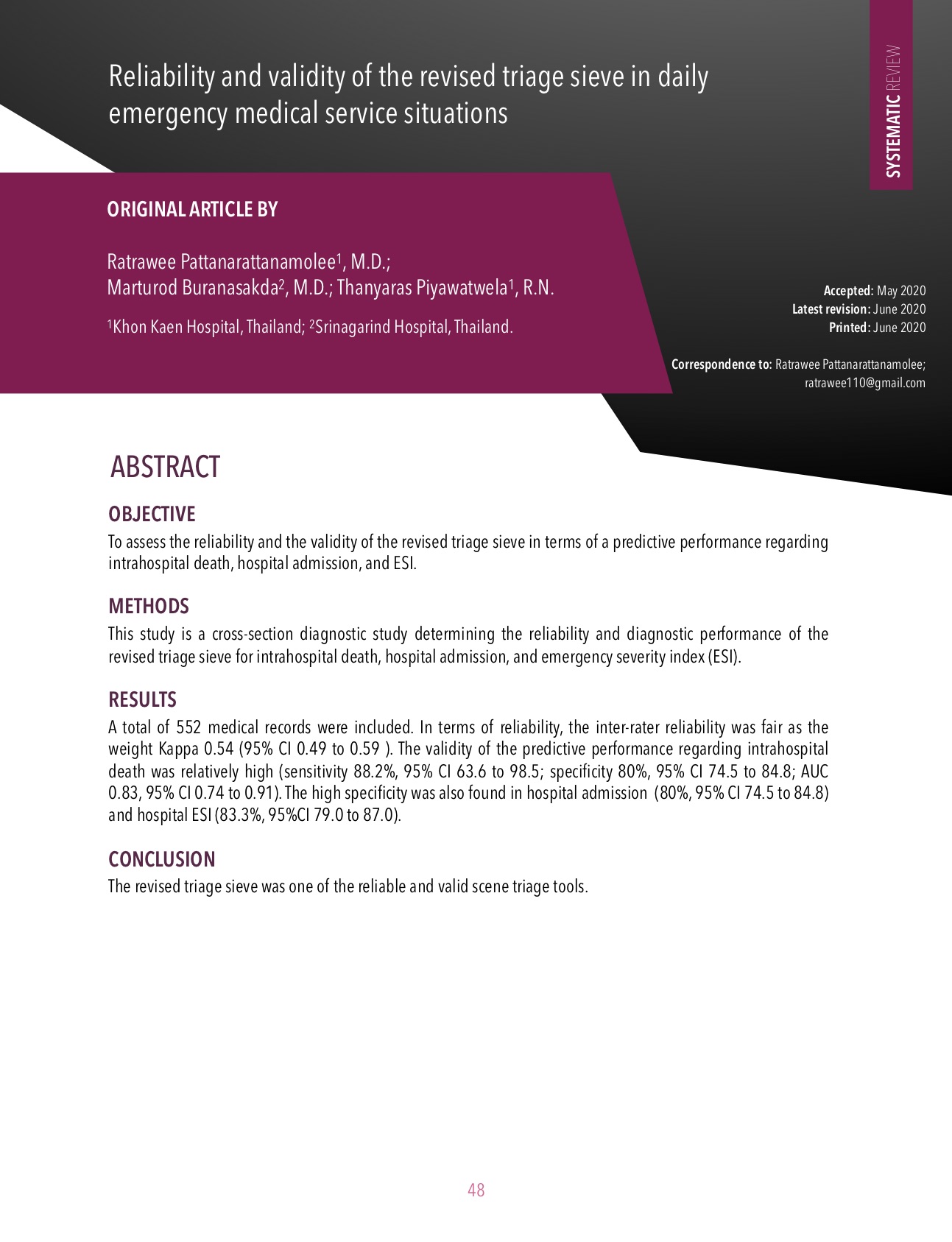Reliability and validity of the revised triage sieve in daily-EMS situation
บทคัดย่อ
OBJECTIVE
To assess the reliability and the validity of the revised triage sieve in terms of a predictive performance regarding intrahospital death, hospital admission, and ESI.
METHODS
This study is a cross-section diagnostic study determining the reliability and diagnostic performance of the revised triage sieve for intrahospital death, hospital admission, and emergency severity index (ESI).
RESULTS
A total of 552 medical records were included. In terms of reliability, the inter-rater reliability was fair as the weight Kappa 0.54 (95% CI 0.49 to 0.59 ). The validity of the predictive performance regarding intrahospital death was relatively high (sensitivity 88.2%, 95% CI 63.6 to 98.5; specificity 80%, 95% CI 74.5 to 84.8; AUC 0.83, 95% CI 0.74 to 0.91). The high specificity was also found in hospital admission (80%, 95% CI 74.5 to 84.8) and hospital ESI (83.3%, 95%CI 79.0 to 87.0).
CONCLUSION
The revised triage sieve was one of the reliable and valid scene triage tools.
เอกสารอ้างอิง
Jenkin A, Abelson-Mitchell N, Cooper S. Patient handover: time for a change? Emerg Nurse. 2007;15(3):141-7.
McHugh M, Tanabe P, McClelland M, Khare RK. More patients are triaged using the Emergency Severity Index than any other triage acuity system in the United States. Acad. Emerg. Med. 2012;19(1):106-9.
Gilboy N, Tanabe P, Travers D, Rosenau AM. Emergency Severity Index (ESI): a triage tool for emergency department care, version 4. Implementation handbook. 2012:12-0014.
National institue of Emergency medicine. Emergency Medical Triage Protocol and Criteria Based Dispatch. Bangkok: National institue of Emergency medicine; 2013.
Wuerz RC, Milne LW, Eitel DR, Travers D, Gilboy N. Reliability and validity of a new five‐level triage instrument. Acad. Emerg. Med. 2000;7(3):236-42.
Eitel DR, Travers DA, Rosenau AM, Gilboy N, Wuerz RC. The emergency severity index triage algorithm version 2 is reliable and valid. Acad. Emerg. Med.2003;10(10):1070-80.
Tanabe P, Gimbel R, Yarnold PR, Adams JG. The Emergency Severity Index (version 3) 5-level triage system scores predict ED resource consumption. J. Emerg. Nurs.2004;30(1):22-9.
National institute of Emergency medicine. เกณฑ์การคัดแยกผู้ป่วยฉุกเฉินและจัดลำดับการบริบาล ณ ห้องฉุกเฉินตามหลักเกณฑ์ที่ กพฉ. กำหนด (ฉบับที่ 1) พ.ศ. 2556. กรุงเทพฯ: สถาบันการแพทย์ฉุกเฉินแห่งชาติ; 2556.
Smith DT, Snyder A, Hollen PJ, Anderson JG, Caterino JM. Analyzing the Usability of the 5-Level Canadian Triage and Acuity Scale By Paramedics in the Prehospital Environment. Emerg Nurse. 2015;41(6):489-95.
Barnett AS, Wang NE, Sahni R, Hsia RY, Haukoos JS, Barton ED, et al. Variation in prehospital use and uptake of the national Field Triage Decision Scheme. Prehosp. Emerg. Care 2013;17(2):135-48.
Kirkpatrick JR, Youmans RL. TRAUMA INDEX: An Aide in the Evaluation of Injury Victims. J. Trauma Acute Care Surg. 1971;11(8):711-4.
Kane G, Engelhardt R, Celentano J, Koenig W, Yamanaka J, McKinney P, et al. Empirical development and evaluation of prehospital trauma triage instruments. J TRAUMA 1985;25(6):482-9.
Koehler JJ, Baer LJ, Malafa SA, Meindertsma M, Navitskas NR, Huizenga JE. Prehospital Index: a scoring system for field triage of trauma victims. ANN EMERG MED 1986;15(2):178-82.
Trauma ACoSCo. Hospital and prehospital resources for optimal care of the injured patient and Appendices A through J: American College of Surgeons; 1986.
Trauma ACoSCo. Resources for optimal care of the injured patient: Amer College of Surgeons; 1990.
Trauma ACoSCo. Resources for optimal care of the injured patient: 1993: College of; 1993.
Trauma ACoSCo. Advanced Trauma life Support® ATLS® Student Course Manual. 9th ed. Chicago: American College of Surgeons; 2012.
Surgeons P-HTLSCotNAoEMTUSicwtCoToACo. PHTLS :Prehospital Trauma Life Support. 8th ed. Burlington, MA: Jones & Bartlett Learning 2014.
Raatiniemi L, Mikkelsen K, Fredriksen K, Wisborg T. Do pre‐hospital anaesthesiologists reliably predict mortality using the NACA severity score? A retrospective cohort study. Acta Anaesthesiol. Scand. 2013;57(10):1253-9.
Weiss M, Bernoulli L, Zollinger A. [The NACA scale. Construct and predictive validity of the NACA scale for prehospital severity rating in trauma patients]. Anaesthesist 2001;50(3):150-4.
Dami F, Golay C, Pasquier M, Fuchs V, Carron P-N, Hugli O. Prehospital triage accuracy in a criteria based dispatch centre. BMC Emerg. Med. 2015;15(1):1.
Leung SC, Leung LP, Fan KL, Yip WL. Can prehospital Modified Early Warning Score identify non‐trauma patients requiring life‐saving intervention in the emergency department? EMERG MED AUSTRALAS 2016;28(1):84-9.
Buschhorn HM, Strout TD, Sholl JM, Baumann MR. Emergency medical services triage using the emergency severity index: is it reliable and valid? J. Emerg. Nurs.2013;39(5):e55-e63.
Lidal IB, Holte HH, Vist GE. Triage systems for pre-hospital emergency medical services-a systematic review. SJTREM 2013;21(1):1.
Smith W. Triage in mass casualty situations. CME. 2012;30(11):413-5.
Horne S, Vassallo J, Read J, Ball S. UK triage–an improved tool for an evolving threat. Injury. 2013;44(1):23-8.
Robertson-Steel I. Evolution of triage systems. United States, North America: BMJ Publishing Group Ltd; 2006.
Russell R BAe. Clinical guidelines for operations. United Kingdom2012.
Fisher JD BS, Cooke MW, et al. UK Ambulance Services Clinical Practice Guidelines. Slovenia: Class Publishing Ltd; 2013.
Vassallo J, Horne S, Ball S, Whitley J.UK Triage the validation of a new tool to counter an evolving threat. Injury. 2014 Dec;45(12):2071-5.
WG C. Sampling Techniques.3rd edition. New York Willey; 1977.
Landis JR, Koch GG. The measurement of observer agreement for categorical data. Biometrics. 1977:159-74.
Altman DG. Practical statistics for medical research: CRC press; 1990Tanabe P, Gimbel R, Yarnold PR, Adams JG. The Emergency Severity Index (version 3) 5-level triage system scores predict ED resource consumption. J. Emerg. Nurs.2004;30(1):22-9.



